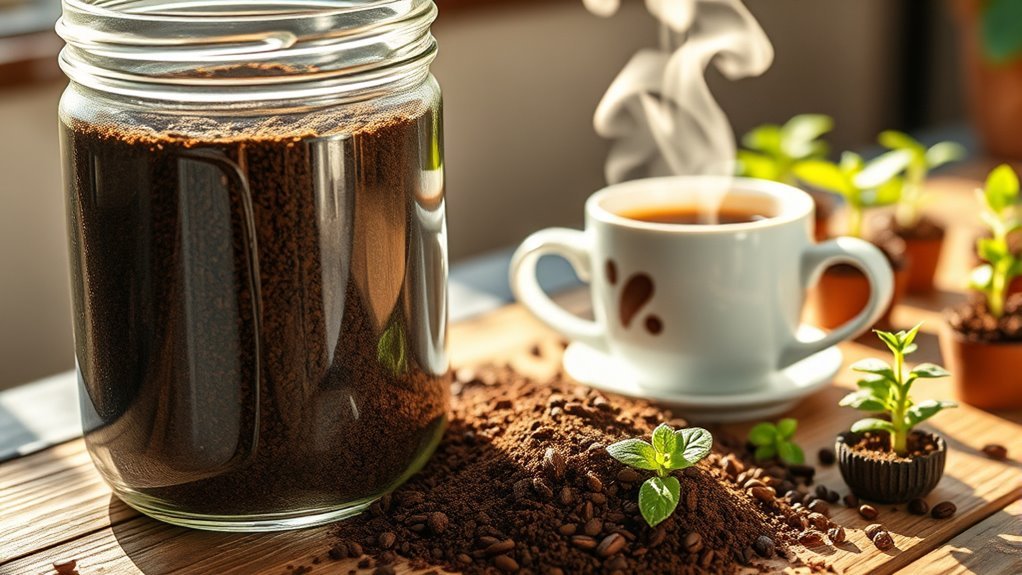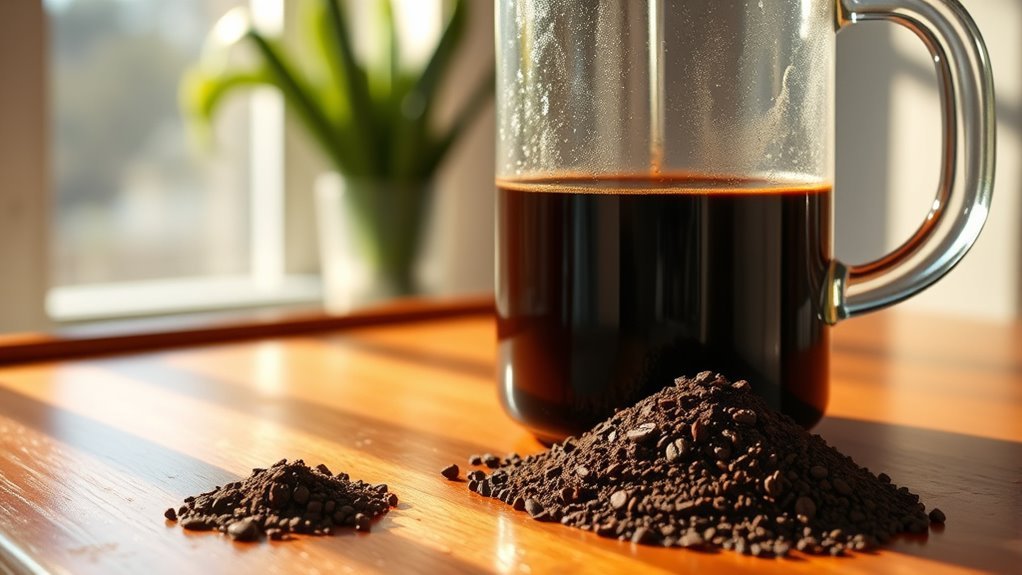Can You Brew Coffee Grounds Twice
Yes, you can brew coffee grounds twice, but it’s crucial to evaluate the outcome. The first brew typically offers a clearer, brighter flavor, while the second may taste weaker and more bitter due to extraction differences. Additionally, reusing grounds can lead to increased acidity, which may not sit well with everyone. However, double brewing can stretch your coffee budget and reduce waste. If you’re curious about techniques and tips for the best results, there’s more to explore.
Understanding the Coffee Brewing Process

When you brew coffee, you’re not just steeping grounds in hot water; you’re engaging in a complex extraction process. Different brewing techniques affect flavor profiles and the overall experience. For instance, methods like pour-over or French press offer distinct ways to extract oils and compounds from various coffee varieties. Each technique emphasizes unique characteristics, ranging from fruity notes to rich, earthy tones. Adjusting factors such as water temperature, grind size, and brewing time can greatly alter the final cup. Understanding these nuances allows you to explore the vast world of coffee more freely, enabling you to tailor your brews to your taste preferences. By mastering these techniques, you elevate not only your coffee experience but also your appreciation for this beloved beverage.
The Science of Extraction
While brewing coffee, you’re fundamentally orchestrating a delicate balance of extraction, where water interacts with coffee grounds to dissolve soluble compounds. The extraction process relies on several factors, including water temperature, grind size, and brewing techniques. Each variable influences the rate and quality of extraction, affecting the final brew.
| Factor | Impact on Extraction | Ideal Range |
|---|---|---|
| Water Temperature | Higher temps speed up extraction | 195°F – 205°F |
| Grind Size | Finer grind increases surface area | Medium to fine |
| Brew Time | Longer times extract more compounds | 4-5 minutes |
| Water Quality | Purity affects flavor and extraction | Filtered water |
| Coffee-to-Water Ratio | Balances strength and flavor | 1:15 – 1:17 |
Understanding these elements helps you refine your brewing technique.
Flavor Profiles: Single Brew vs. Double Brew

When you brew coffee grounds once, you typically extract a balanced flavor profile rich in aroma and complexity. However, brewing the same grounds a second time can lead to diminished flavor and a shift towards more bitter and astringent notes. Understanding these differences can help you make informed choices about your brewing methods and desired taste experience.
Single Brew Flavor Profile
The flavor profile of a single brew is often characterized by its clarity and distinctiveness, showcasing the unique qualities of the coffee beans. With single brew intensity, you experience a vibrant expression of flavors, making each sip feel alive. This method highlights the single brew aroma, which can range from fruity and floral to nutty and chocolaty, depending on the origin and roast of the beans. You’ll notice that the subtleties in taste become more pronounced, allowing you to appreciate the intricacies of your chosen coffee. Since the extraction process is focused, you get a cleaner cup that avoids muddling flavors, making it easier to identify the specific characteristics that make your coffee special. Enjoy this freedom of exploration with each brew.
Double Brew Flavor Impact
Exploring double brewing introduces a different layer to your coffee experience, contrasting sharply with the clarity found in single brews. The flavor intensity shifts markedly, as the second brew extracts compounds that might’ve been overlooked initially. You may notice:
- Reduced Brightness: The vibrant notes can be dulled, leading to a more uniform flavor profile.
- Increased Bitterness: Extended extraction can amplify bitter elements, altering your perception of balance.
- Aroma Changes: The second brew often lacks the fresh aromas of the first, presenting a heavier, less complex scent.
While some may appreciate the deeper body, others might miss the nuanced flavors of a single brew. Understanding these elements allows you to embrace your freedom in coffee preferences fully.
Potential Benefits of Brewing Coffee Grounds Twice
Although many coffee enthusiasts might dismiss the idea of brewing coffee grounds twice, there are compelling reasons to contemplate it. First, consider the sustainability benefits; by reusing coffee grounds, you’re reducing waste and promoting a more eco-friendly approach to your daily brew. This practice aligns with a growing desire for sustainable living. Additionally, there are notable cost savings involved. Instead of tossing out used grounds, you can brew a second cup, stretching your coffee budget further. While the flavor profile may differ, you can still enjoy a satisfying drink. Embracing this method not only supports personal finances but also contributes positively to environmental efforts, giving you the freedom to enjoy coffee while being conscious of your impact.
Drawbacks of Double Brewing

While reusing coffee grounds may seem like an appealing option, it’s important to recognize the potential drawbacks associated with double brewing. Here are three key issues you might encounter:
- Flavor Dilution: The second brew often lacks the robust flavors of the first, resulting in a weaker and less satisfying cup of coffee.
- Acidity Increase: Re-brewing can lead to a higher acidity level, which may not only alter the taste but could also lead to stomach discomfort for some drinkers.
- Bacterial Growth: Used coffee grounds can harbor bacteria, especially if left unsealed, which could affect your health and the quality of your brew.
Understanding these drawbacks helps you make informed decisions about your coffee brewing practices.
Tips for Successful Double Brewing
If you decide to double brew your coffee grounds, there are several strategies to enhance your experience and mitigate some of the downsides. First, use fresh, high-quality beans for your initial brew; this sets a solid foundation. When employing double brewing techniques, consider adjusting the water temperature and brew time for the second round, as reused grounds may require different parameters. Aim for a coarser grind to prevent over-extraction during the second brew. Additionally, experiment with flavorings or additives to mask any bitterness from coffee ground reuse. Don’t forget to keep a close eye on your coffee’s flavor profile, adjusting as necessary to achieve your desired taste. These tips can help you enjoy a satisfying second cup.
Alternative Uses for Used Coffee Grounds

Used coffee grounds aren’t just waste; they have several practical applications that can benefit your home and lifestyle. You can transform them into a nutrient-rich fertilizer for your plants, a natural deodorizer for various spaces, or even an exfoliating scrub for your skin. Exploring these alternative uses can help you maximize the value of your coffee routine while promoting sustainability.
Fertilizer for Plants
Coffee grounds can be a valuable addition to your garden, serving as a natural fertilizer that enriches the soil. As a coffee ground fertilizer, they provide a plant nutrient boost, offering essential nitrogen and other minerals. Here’s how to use them effectively:
- Soil Amendment: Mix used coffee grounds into the soil to improve texture and drainage.
- Composting: Add them to your compost pile. They balance carbon-rich materials and accelerate decomposition.
- Mulching: Spread a thin layer around plants to retain moisture and suppress weeds.
Incorporating coffee grounds into your gardening routine not only recycles waste but also enhances your plants’ growth, making it a sustainable choice to foster a flourishing garden.
Natural Deodorizer Solution
A natural deodorizer solution can be easily crafted from leftover coffee grounds, offering an eco-friendly alternative to synthetic air fresheners. Coffee grounds absorb odors effectively, making them a versatile option for various spaces. You can place them in an open container in your refrigerator or sprinkle them in your shoes to neutralize unpleasant smells.
Here’s a simple table to illustrate some practical uses:
| Location | Application |
|---|---|
| Refrigerator | Place in an open bowl |
| Shoes | Sprinkle inside |
| Kitchen countertop | Use in a small sachet |
| Trash can | Mix with baking soda |
Using coffee grounds as a natural deodorizer not only reduces waste but also enhances your environment without harmful chemicals.
Exfoliating Skin Scrub
Leftover coffee grounds can serve multiple purposes beyond deodorizing your space; they also make an excellent exfoliating skin scrub. Using coffee grounds for skincare offers notable exfoliating benefits, promoting skin rejuvenation by removing dead skin cells and stimulating circulation. Here’s how you can incorporate them into your routine:
- Combine with Coconut Oil: Mix coffee grounds with coconut oil for a hydrating, exfoliating paste.
- Add Honey: Blend with honey to create a nourishing scrub that also moisturizes your skin.
- Use with Yogurt: Mix coffee grounds with yogurt for a soothing scrub packed with probiotics.
Frequently Asked Questions
Can I Use the Same Coffee Grounds for Different Brewing Methods?
You’ve got options when it comes to using the same coffee grounds for various brewing techniques. While it may seem like a delightful shortcut, be aware that flavor extraction diminishes with each brew. The first cup offers rich nuances, while subsequent brewing may yield a more muted experience. If you’re after variety, consider different methods, but don’t expect the same vibrant taste. Embrace the journey of discovery with each cup you make!
How Many Times Can I Brew Coffee Grounds Safely?
When it comes to brewing coffee grounds, you can typically extract flavor and aroma effectively just once. After the first brew, most of the desirable compounds are gone, leading to a diminished flavor profile. If you try brewing them again, you might get a faint taste, but the coffee extraction will be weak and unbalanced. For the best experience, it’s better to use fresh grounds for each brew to enjoy that rich flavor.
Does Double Brewing Affect Caffeine Content?
Double brewing does affect caffeine content, primarily due to caffeine extraction diminishing with each brew. The first extraction yields the highest caffeine concentration, while subsequent brews result in lower amounts. This decrease can alter the flavor profile, making it less robust and more diluted. If you’re looking for a stronger caffeine kick, relying on fresh grounds is your best bet. Experimenting with brewing methods can offer a balance between caffeine and flavor.
Can I Store Used Coffee Grounds for Later Brewing?
Imagine a jar filled with the rich aroma of yesterday’s brew, waiting patiently for its second chance. You can absolutely store used coffee grounds for later brewing, but freshness retention is key. Keep them in an airtight container in the fridge to minimize moisture and odor absorption. Ideally, use them within a few days for best flavor. Experiment with your storage methods and enjoy the freedom of exploring different brews!
What’S the Best Way to Dispose of Used Coffee Grounds?
When it comes to disposing of used coffee grounds, consider composting them for their many benefits. They enrich compost piles, adding nitrogen, which is essential for healthy soil. You can also use them directly as a garden fertilizer, enhancing soil structure and attracting earthworms. This eco-friendly option not only reduces waste but promotes a thriving garden, giving you the satisfaction of contributing to a sustainable environment while enjoying your coffee ritual.






